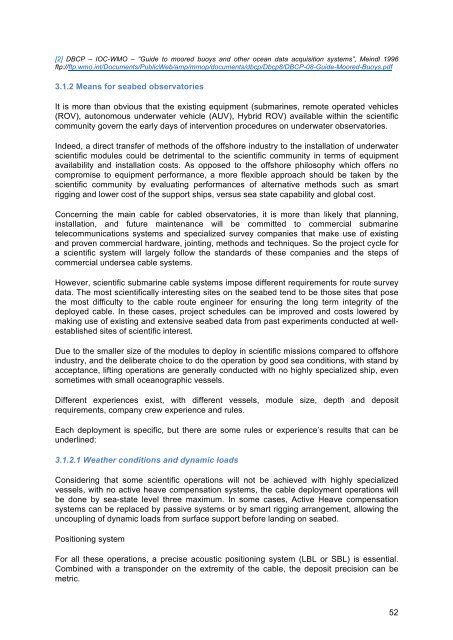Handbook of best practices
Handbook%20of%20best%20practices
Handbook%20of%20best%20practices
You also want an ePaper? Increase the reach of your titles
YUMPU automatically turns print PDFs into web optimized ePapers that Google loves.
[2] DBCP – IOC-WMO – “Guide to moored buoys and other ocean data acquisition systems”, Meindl 1996<br />
ftp://ftp.wmo.int/Documents/PublicWeb/amp/mmop/documents/dbcp/Dbcp8/DBCP-08-Guide-Moored-Buoys.pdf<br />
3.1.2 Means for seabed observatories<br />
It is more than obvious that the existing equipment (submarines, remote operated vehicles<br />
(ROV), autonomous underwater vehicle (AUV), Hybrid ROV) available within the scientific<br />
community govern the early days <strong>of</strong> intervention procedures on underwater observatories.<br />
Indeed, a direct transfer <strong>of</strong> methods <strong>of</strong> the <strong>of</strong>fshore industry to the installation <strong>of</strong> underwater<br />
scientific modules could be detrimental to the scientific community in terms <strong>of</strong> equipment<br />
availability and installation costs. As opposed to the <strong>of</strong>fshore philosophy which <strong>of</strong>fers no<br />
compromise to equipment performance, a more flexible approach should be taken by the<br />
scientific community by evaluating performances <strong>of</strong> alternative methods such as smart<br />
rigging and lower cost <strong>of</strong> the support ships, versus sea state capability and global cost.<br />
Concerning the main cable for cabled observatories, it is more than likely that planning,<br />
installation, and future maintenance will be committed to commercial submarine<br />
telecommunications systems and specialized survey companies that make use <strong>of</strong> existing<br />
and proven commercial hardware, jointing, methods and techniques. So the project cycle for<br />
a scientific system will largely follow the standards <strong>of</strong> these companies and the steps <strong>of</strong><br />
commercial undersea cable systems.<br />
However, scientific submarine cable systems impose different requirements for route survey<br />
data. The most scientifically interesting sites on the seabed tend to be those sites that pose<br />
the most difficulty to the cable route engineer for ensuring the long term integrity <strong>of</strong> the<br />
deployed cable. In these cases, project schedules can be improved and costs lowered by<br />
making use <strong>of</strong> existing and extensive seabed data from past experiments conducted at wellestablished<br />
sites <strong>of</strong> scientific interest.<br />
Due to the smaller size <strong>of</strong> the modules to deploy in scientific missions compared to <strong>of</strong>fshore<br />
industry, and the deliberate choice to do the operation by good sea conditions, with stand by<br />
acceptance, lifting operations are generally conducted with no highly specialized ship, even<br />
sometimes with small oceanographic vessels.<br />
Different experiences exist, with different vessels, module size, depth and deposit<br />
requirements, company crew experience and rules.<br />
Each deployment is specific, but there are some rules or experience’s results that can be<br />
underlined:<br />
3.1.2.1 Weather conditions and dynamic loads<br />
Considering that some scientific operations will not be achieved with highly specialized<br />
vessels, with no active heave compensation systems, the cable deployment operations will<br />
be done by sea-state level three maximum. In some cases, Active Heave compensation<br />
systems can be replaced by passive systems or by smart rigging arrangement, allowing the<br />
uncoupling <strong>of</strong> dynamic loads from surface support before landing on seabed.<br />
Positioning system<br />
For all these operations, a precise acoustic positioning system (LBL or SBL) is essential.<br />
Combined with a transponder on the extremity <strong>of</strong> the cable, the deposit precision can be<br />
metric.<br />
52


